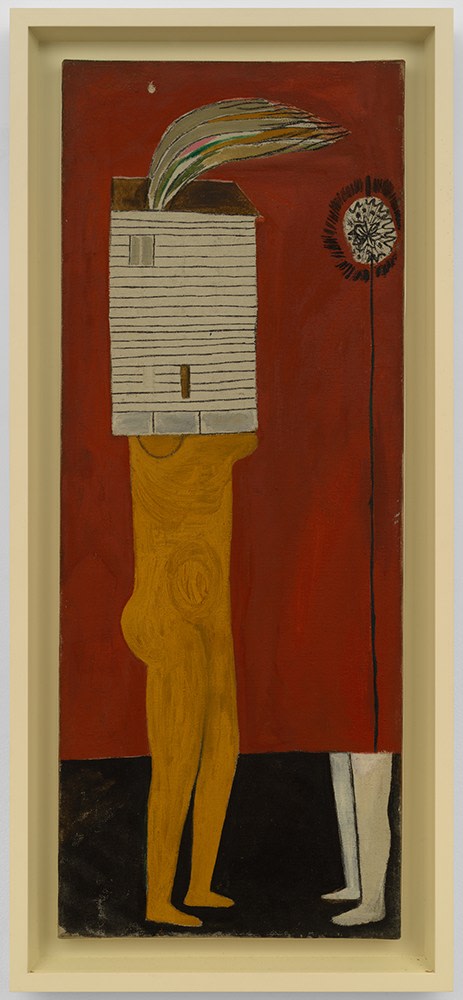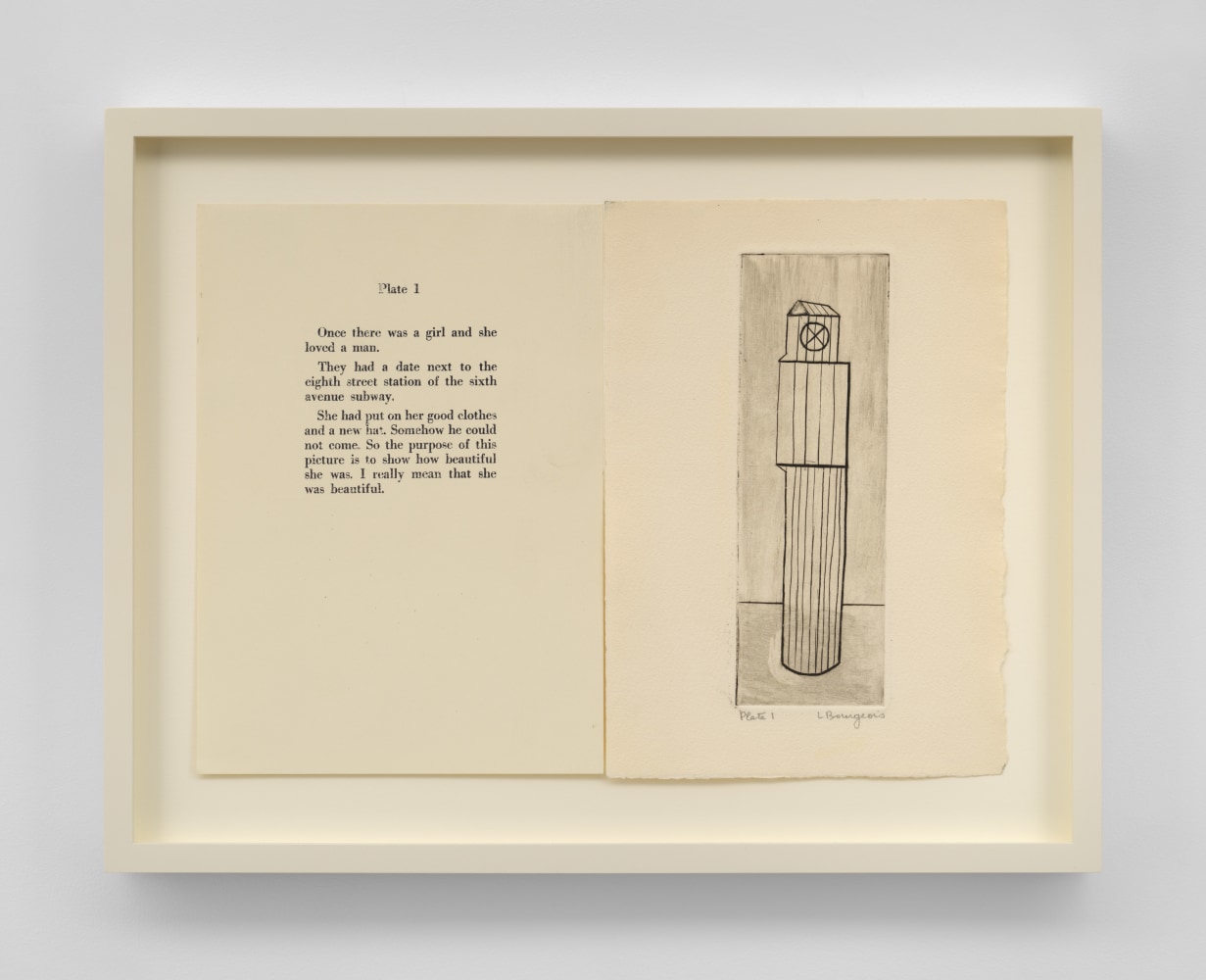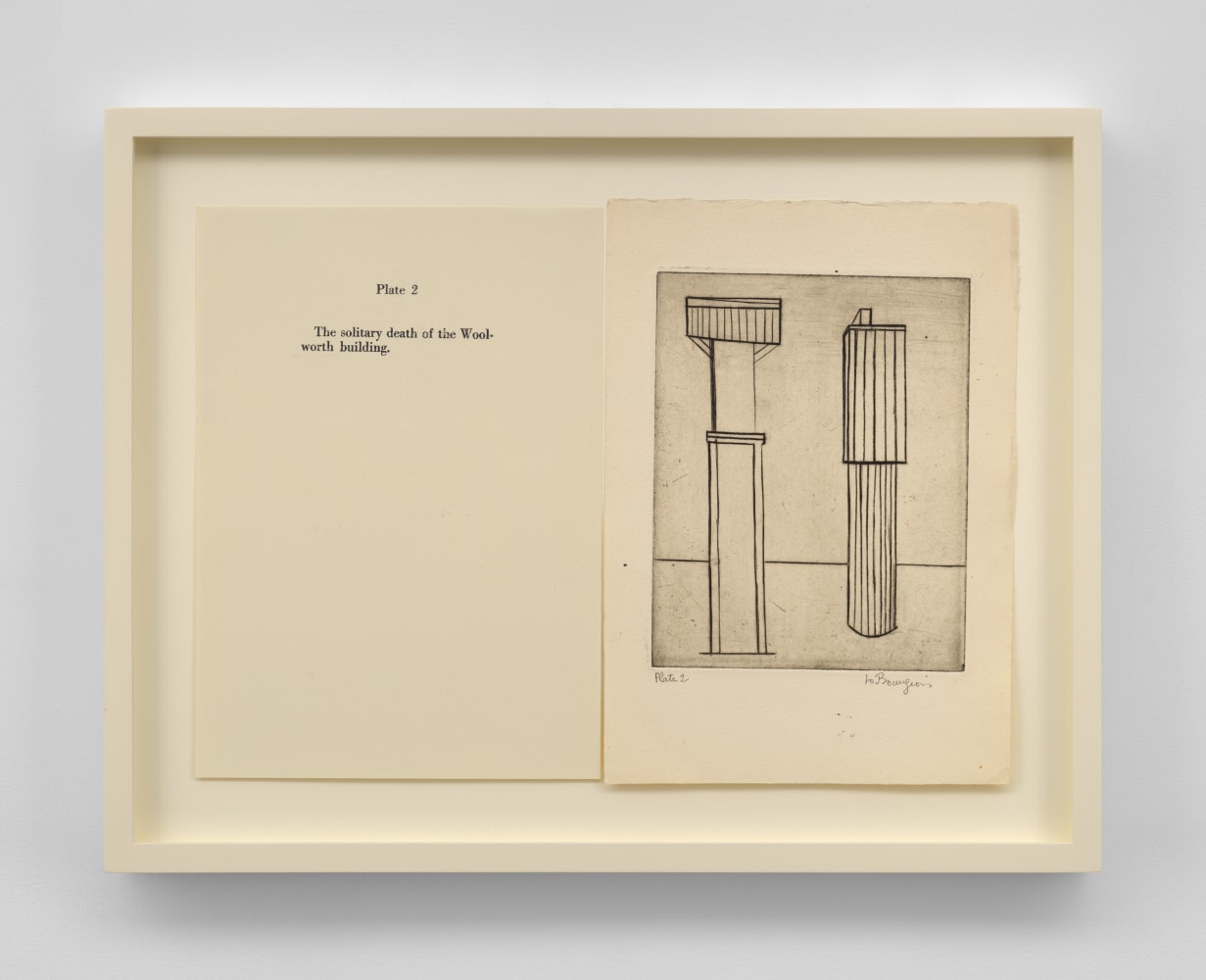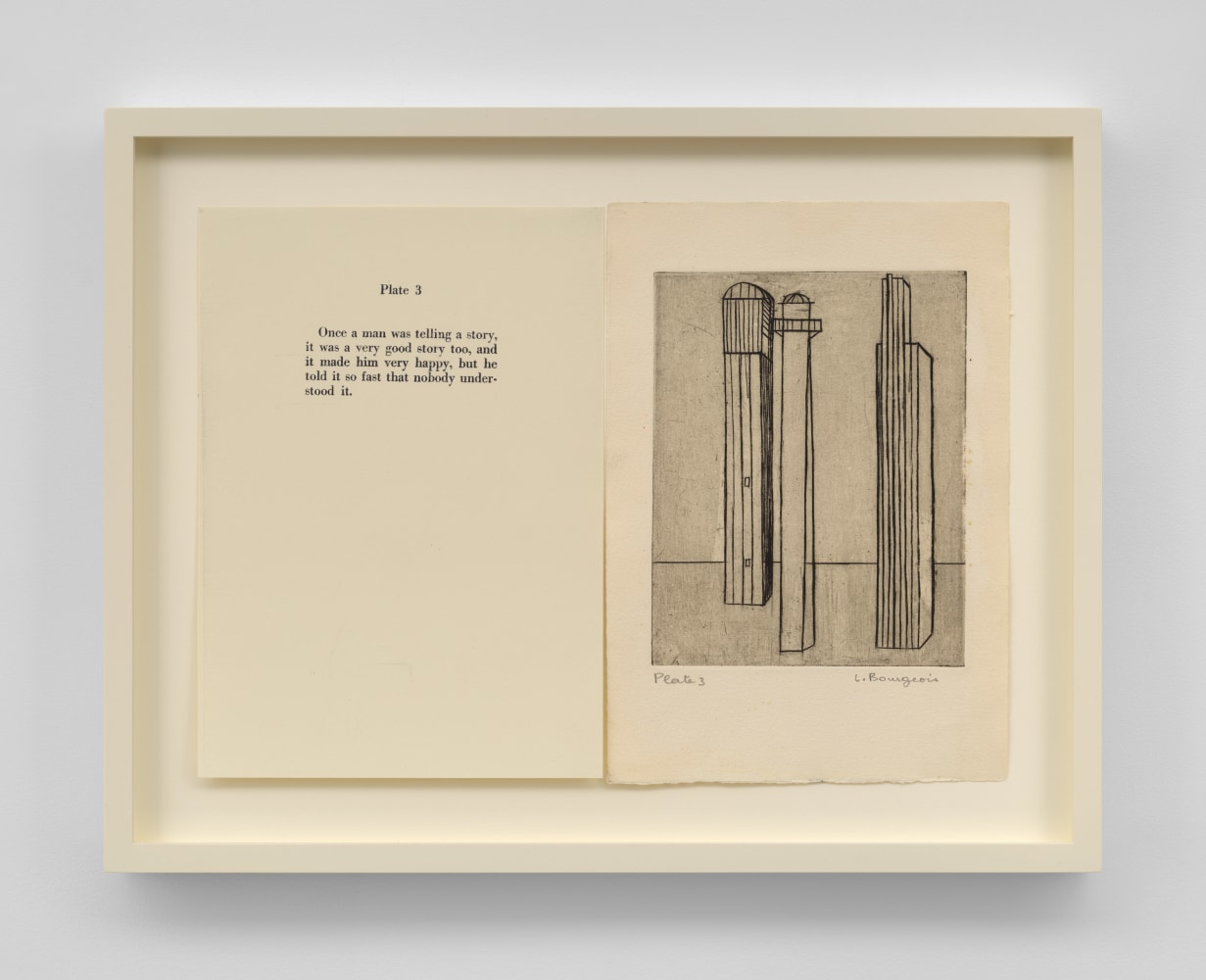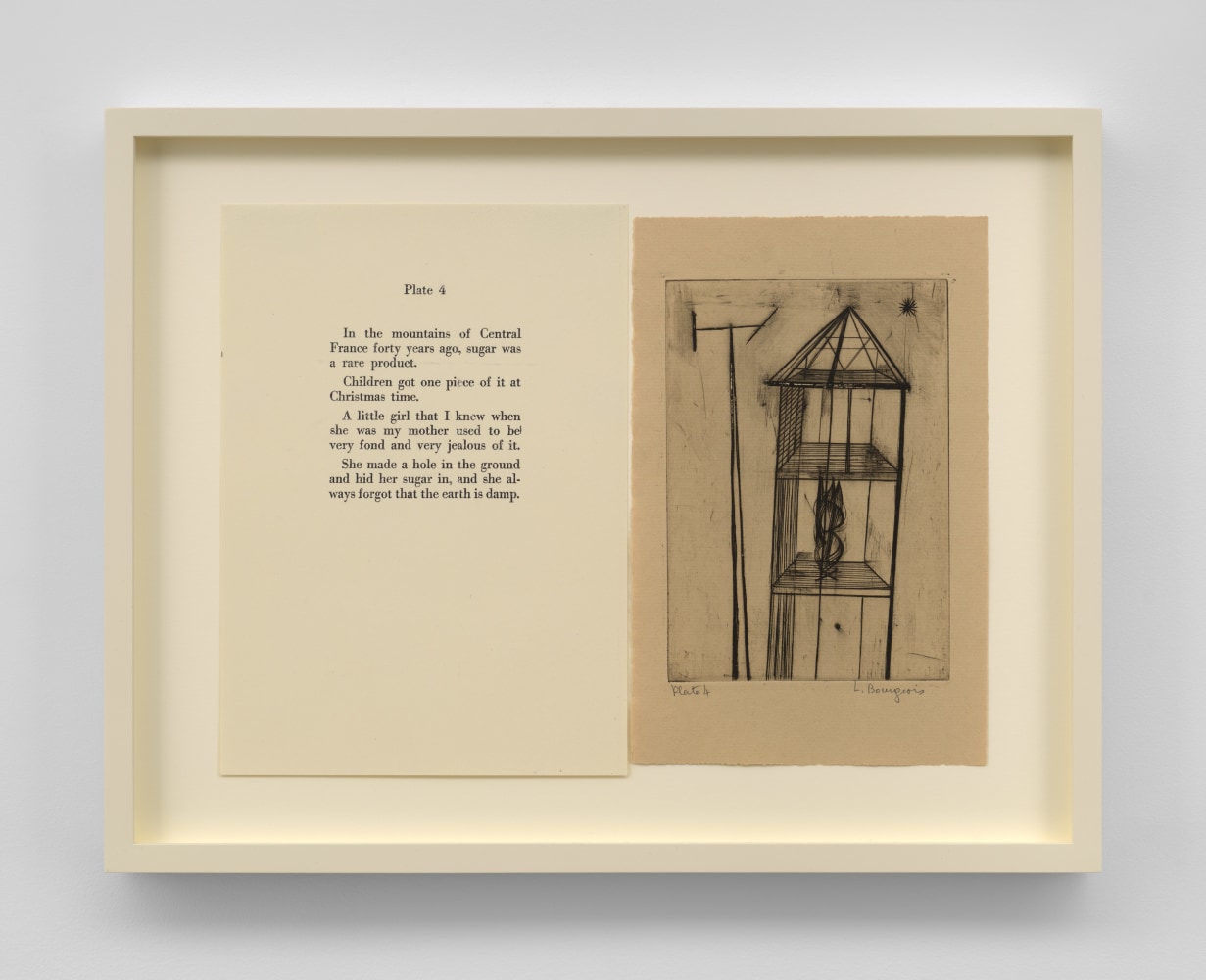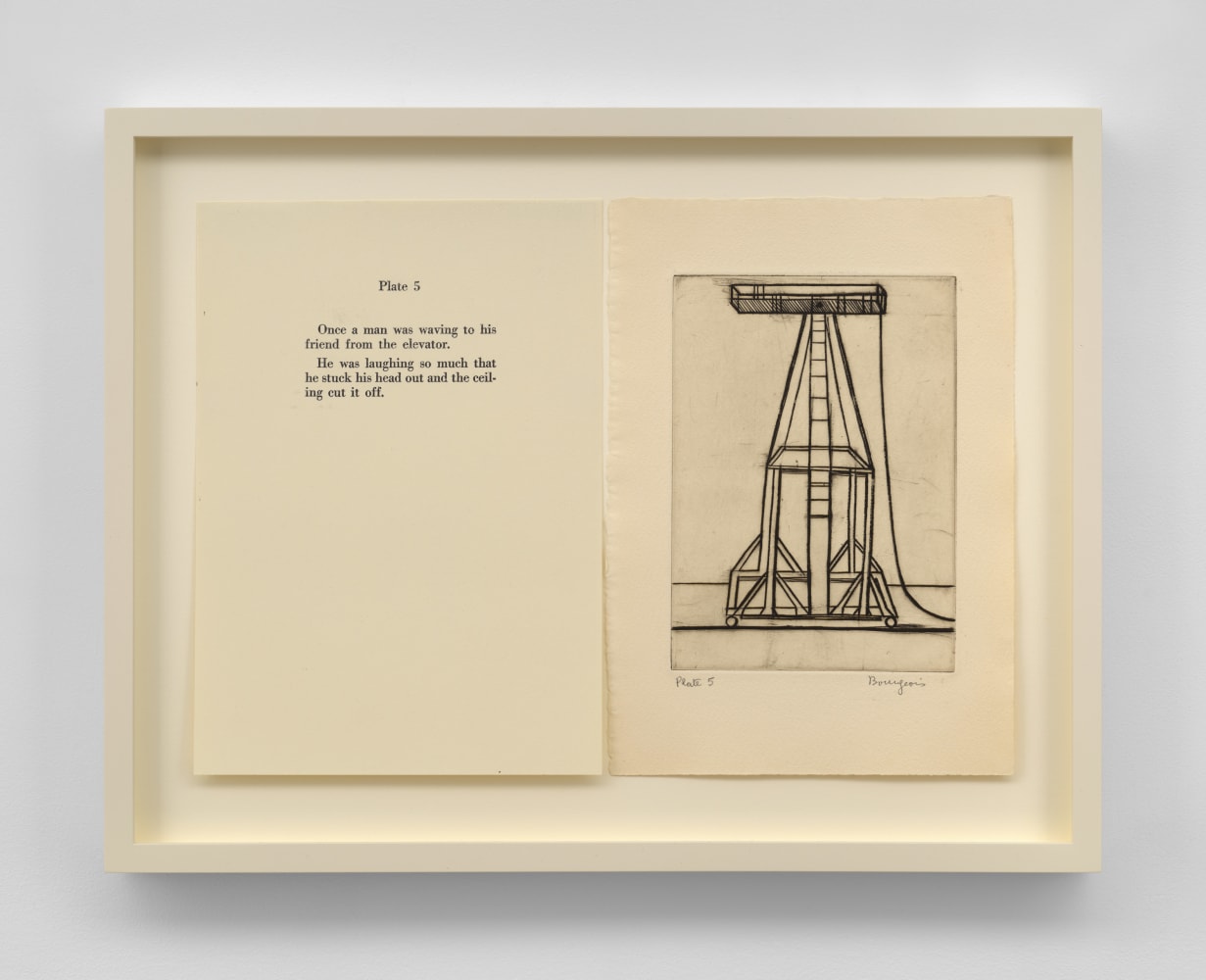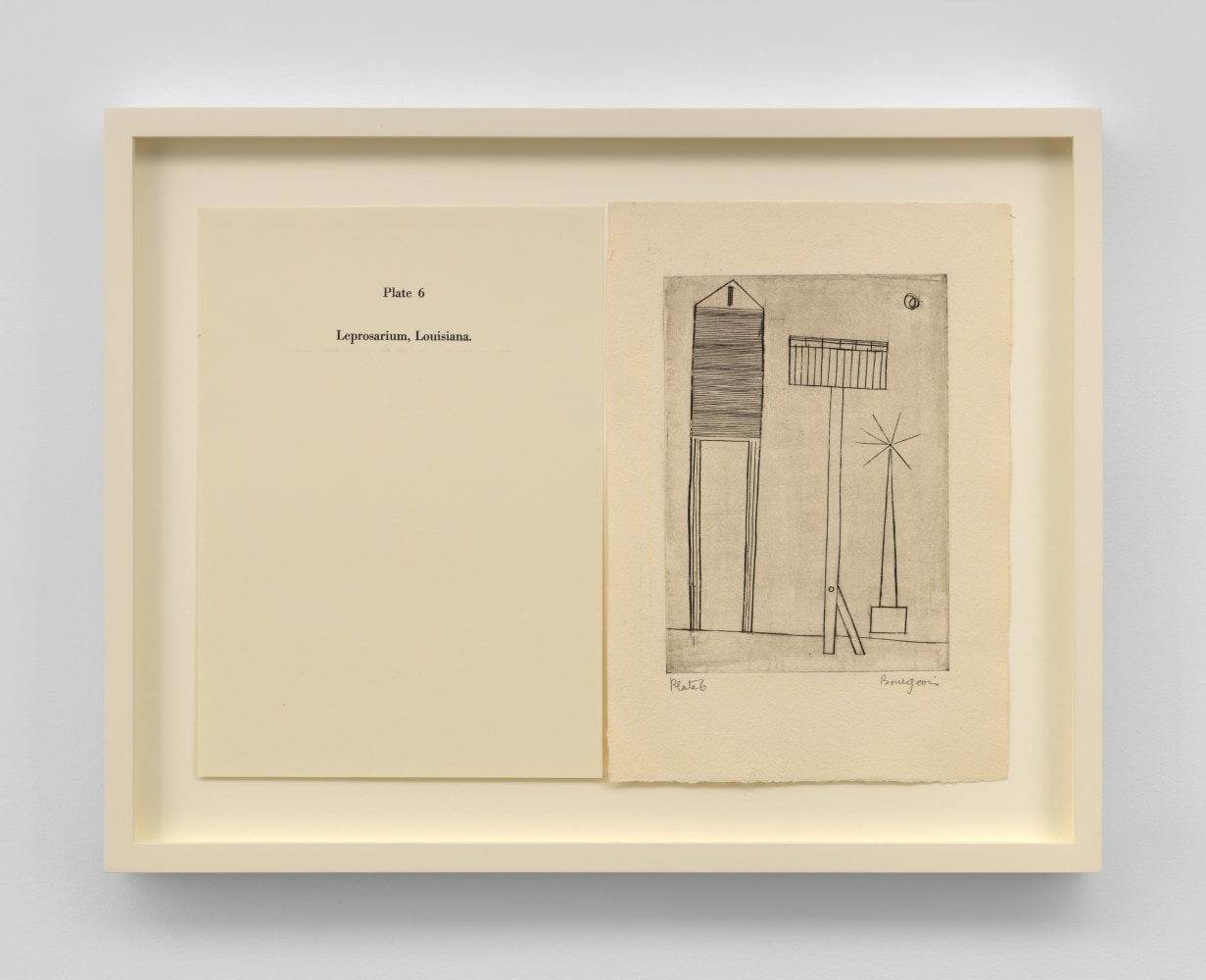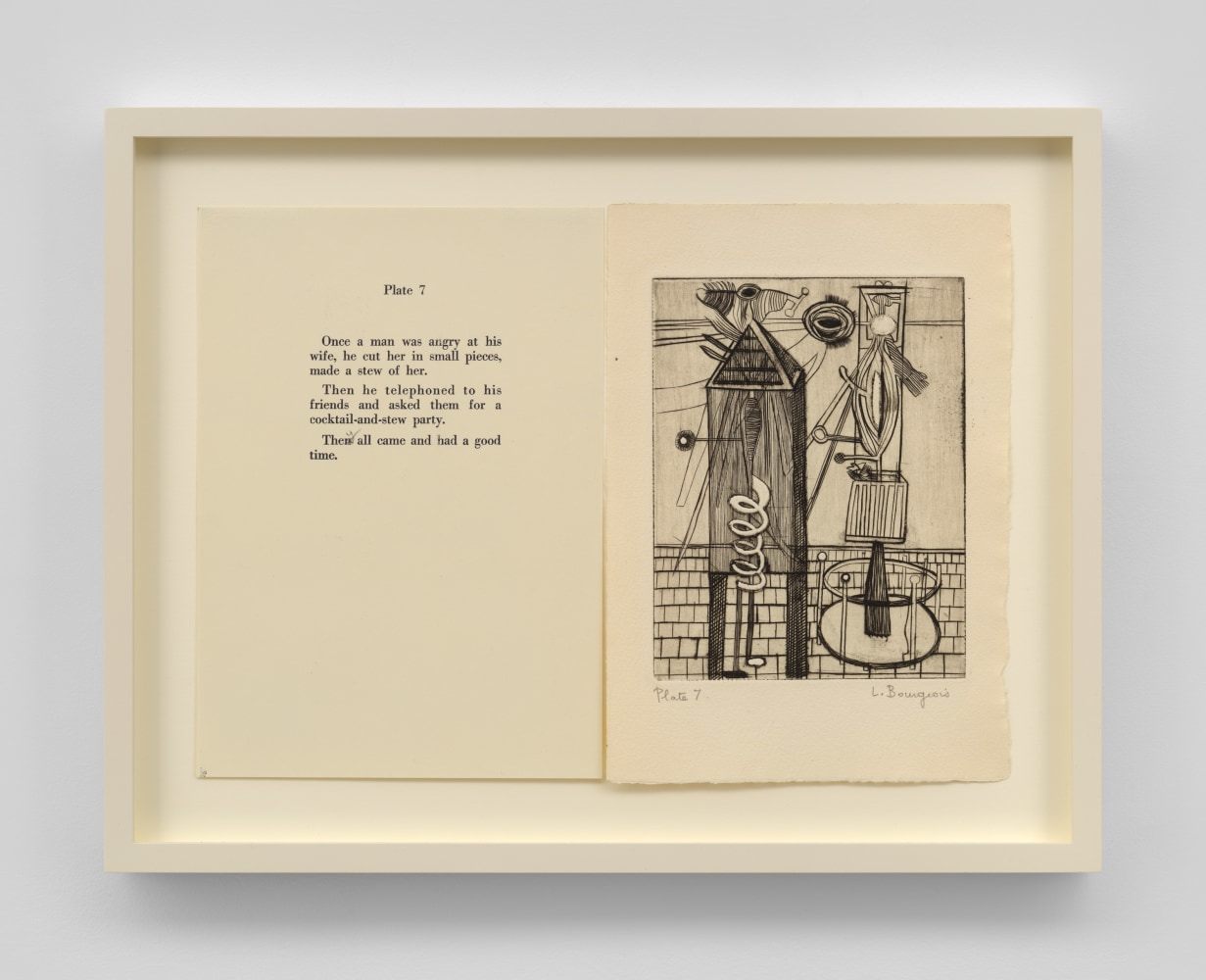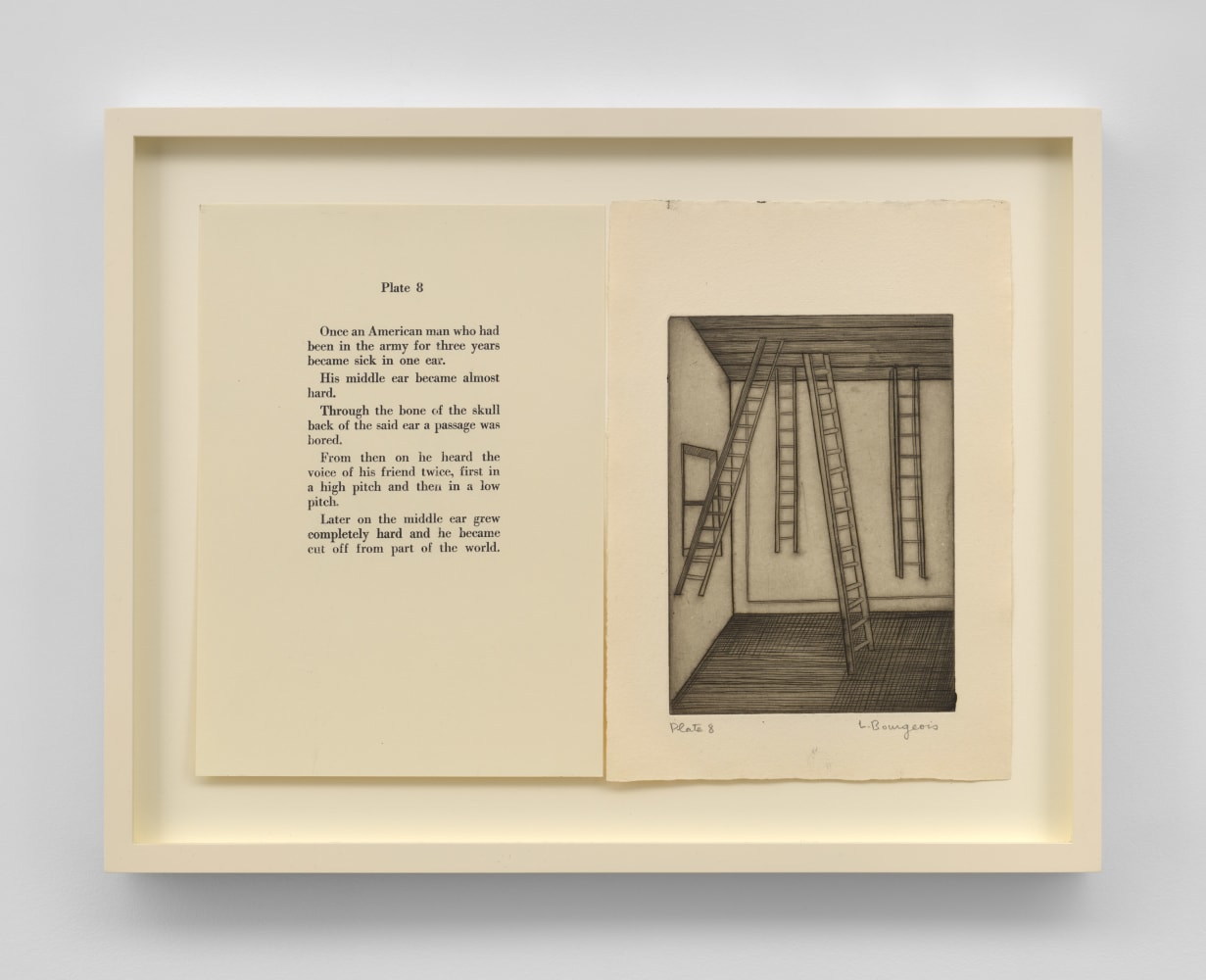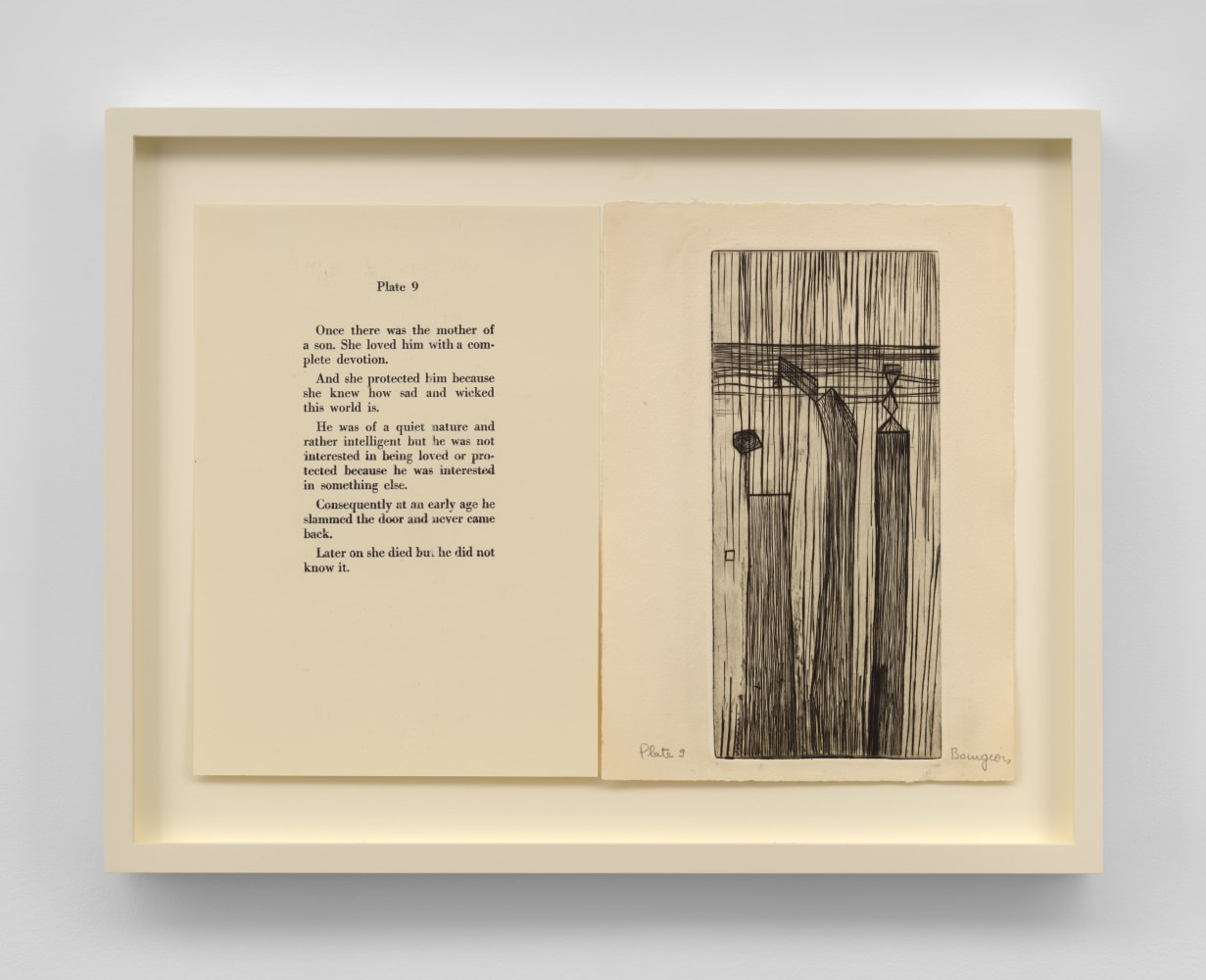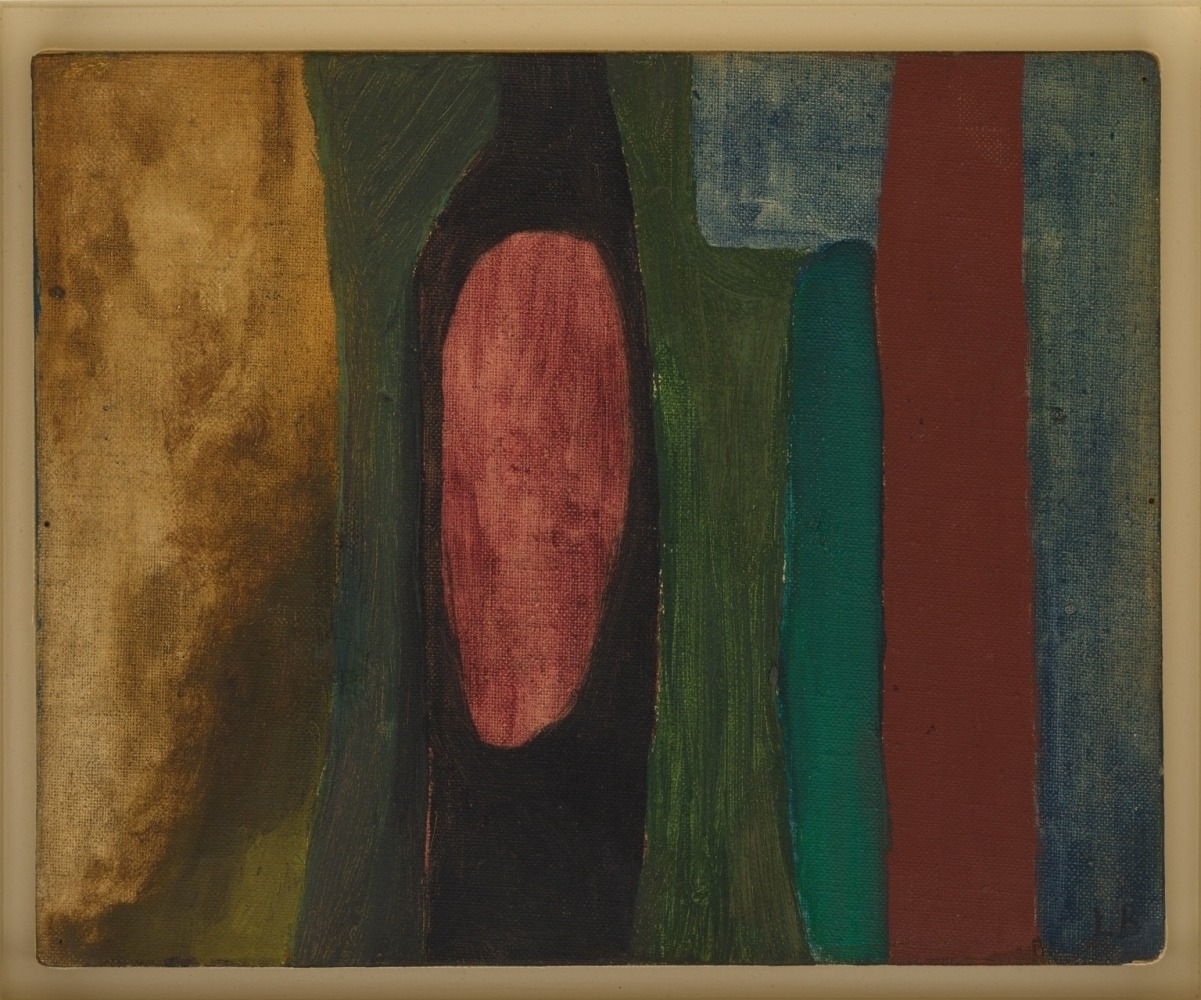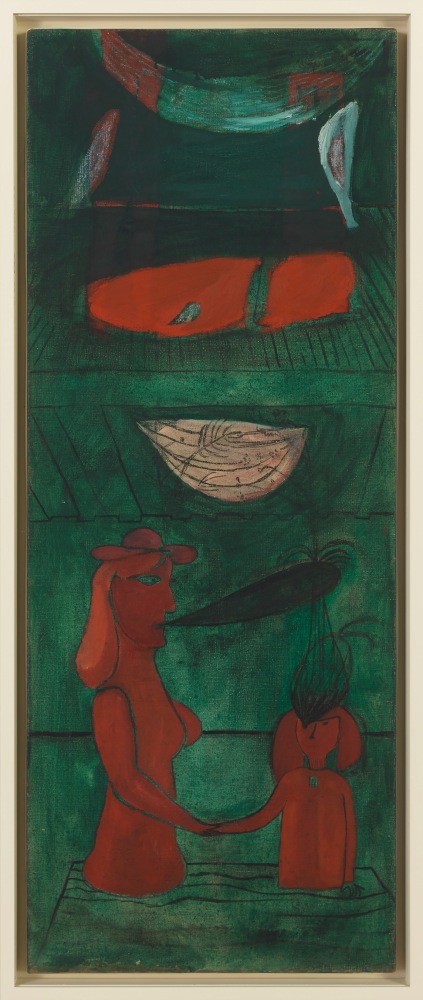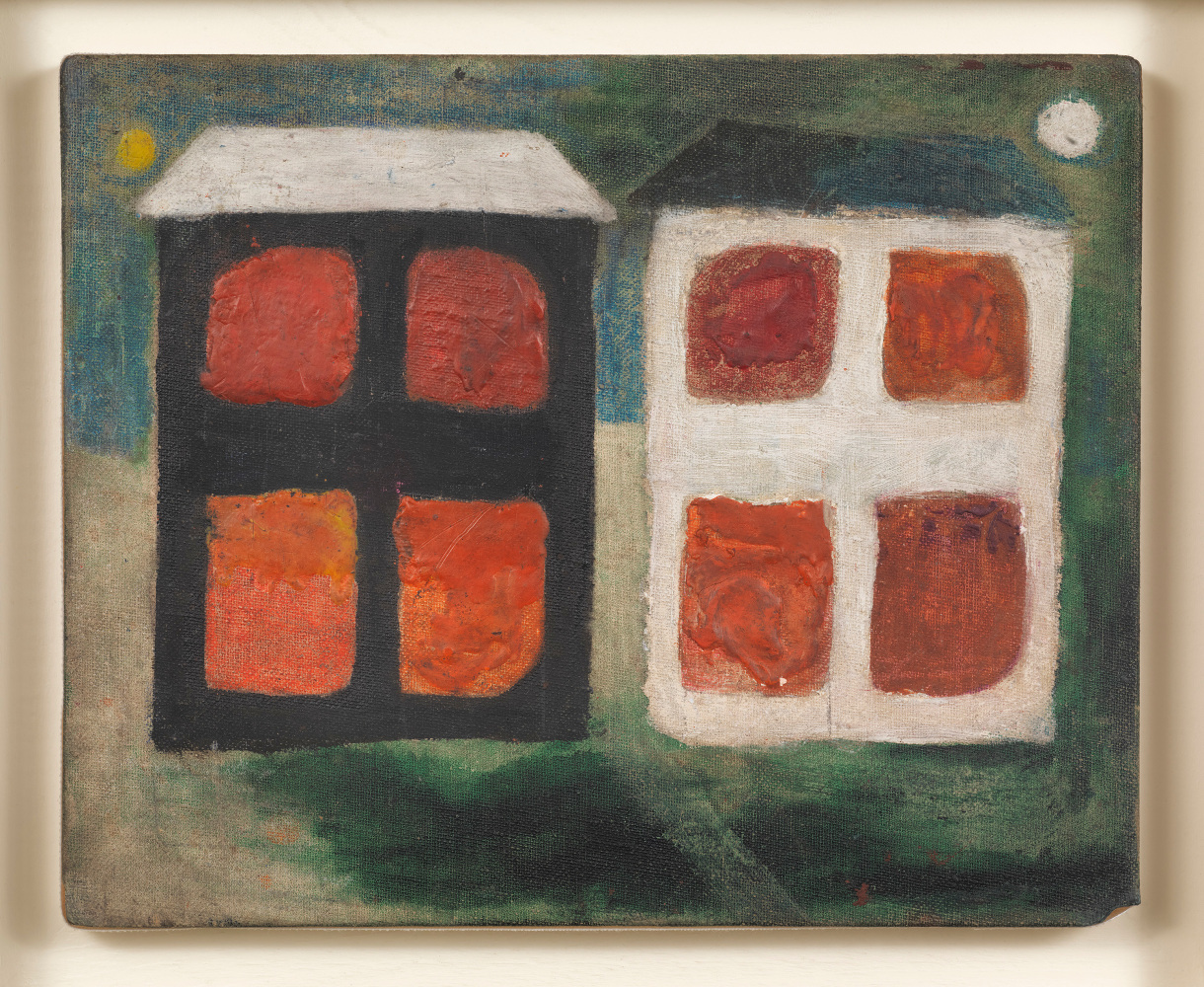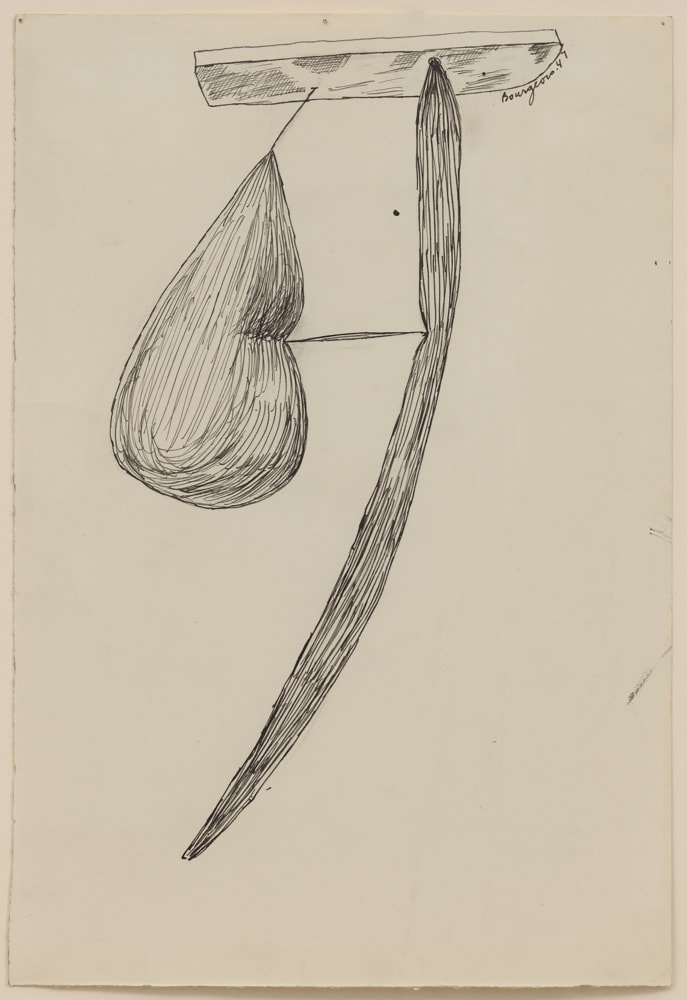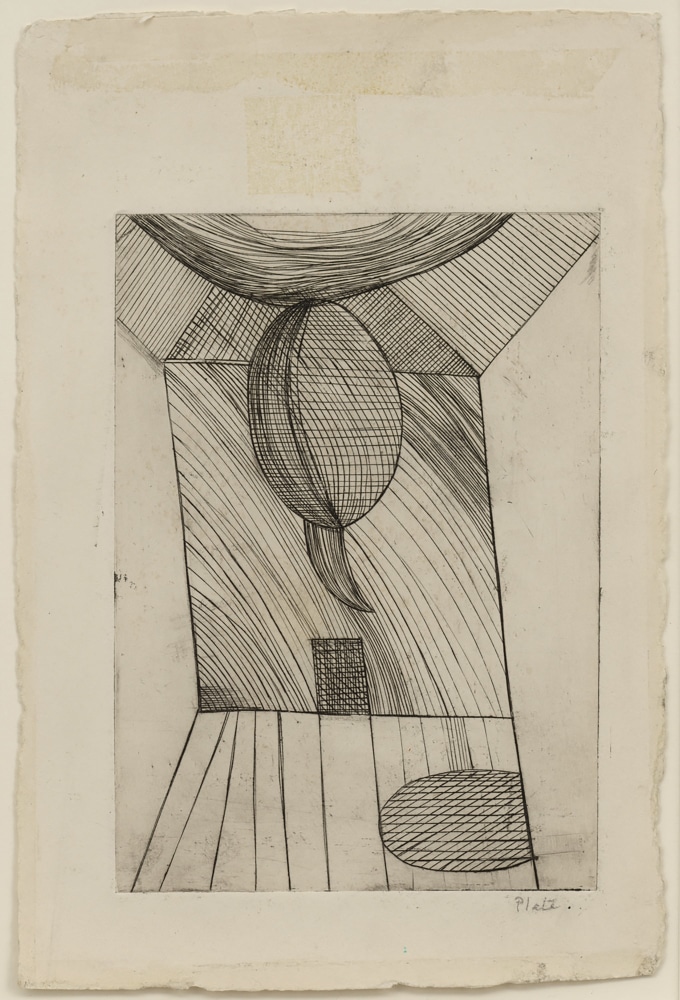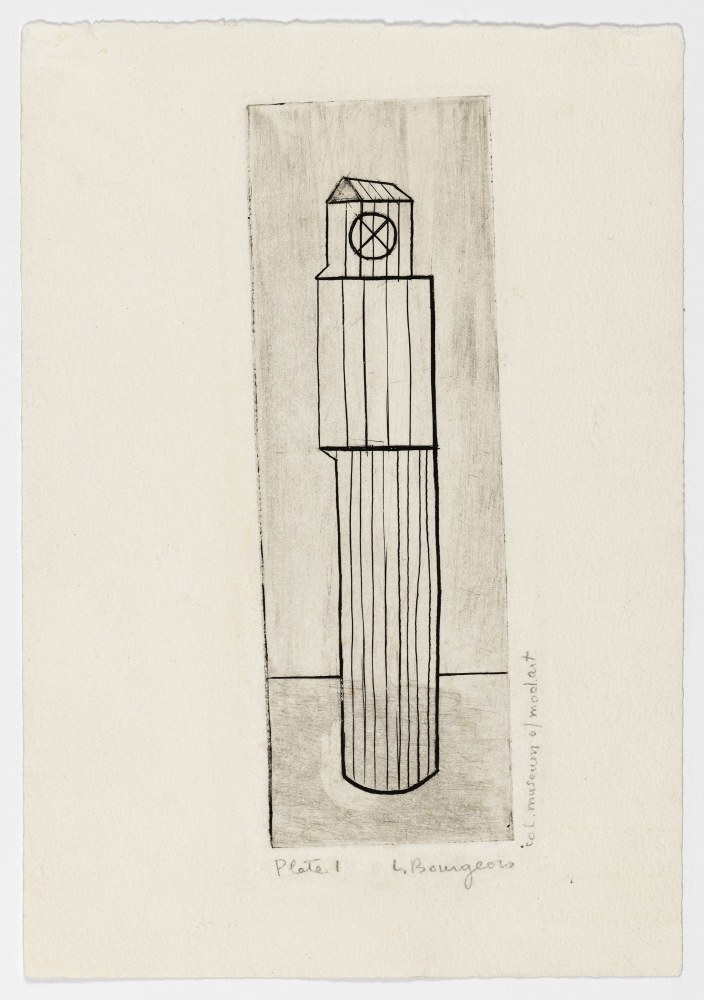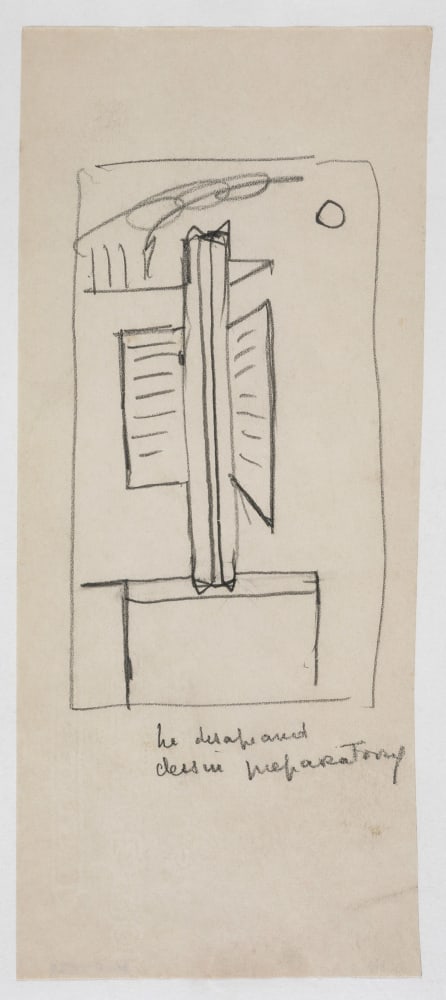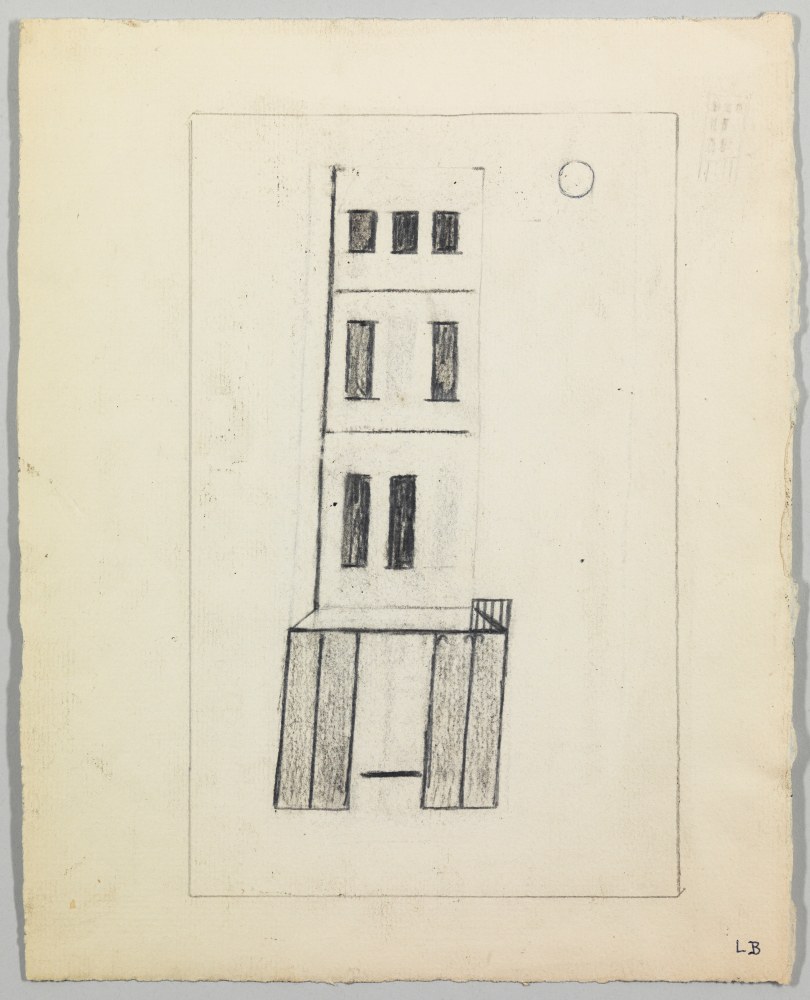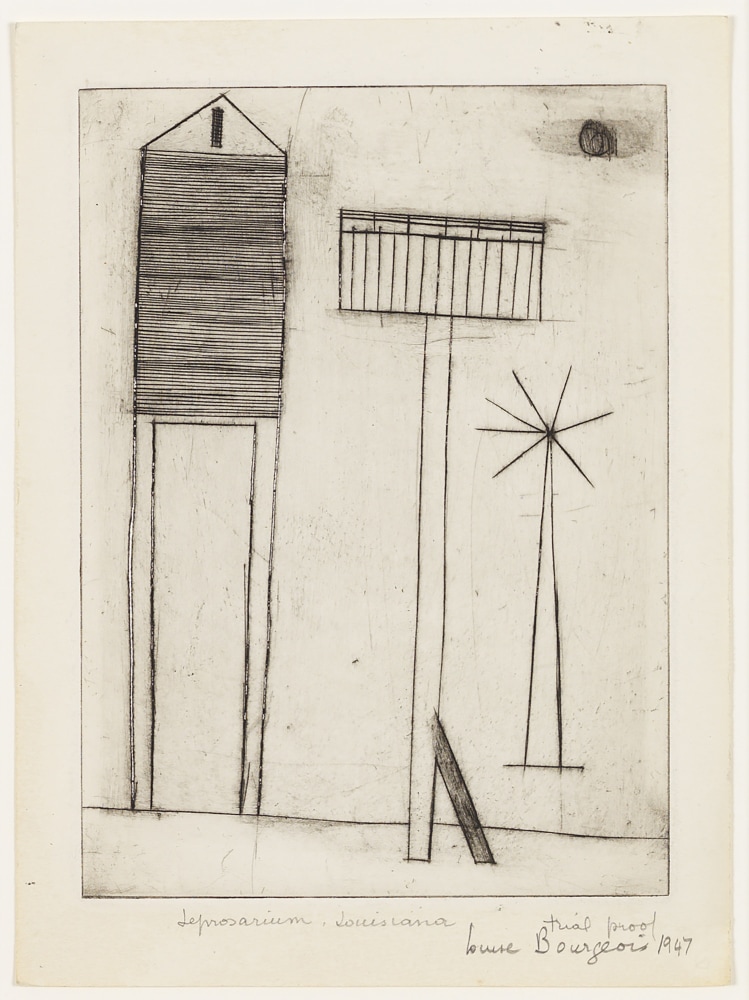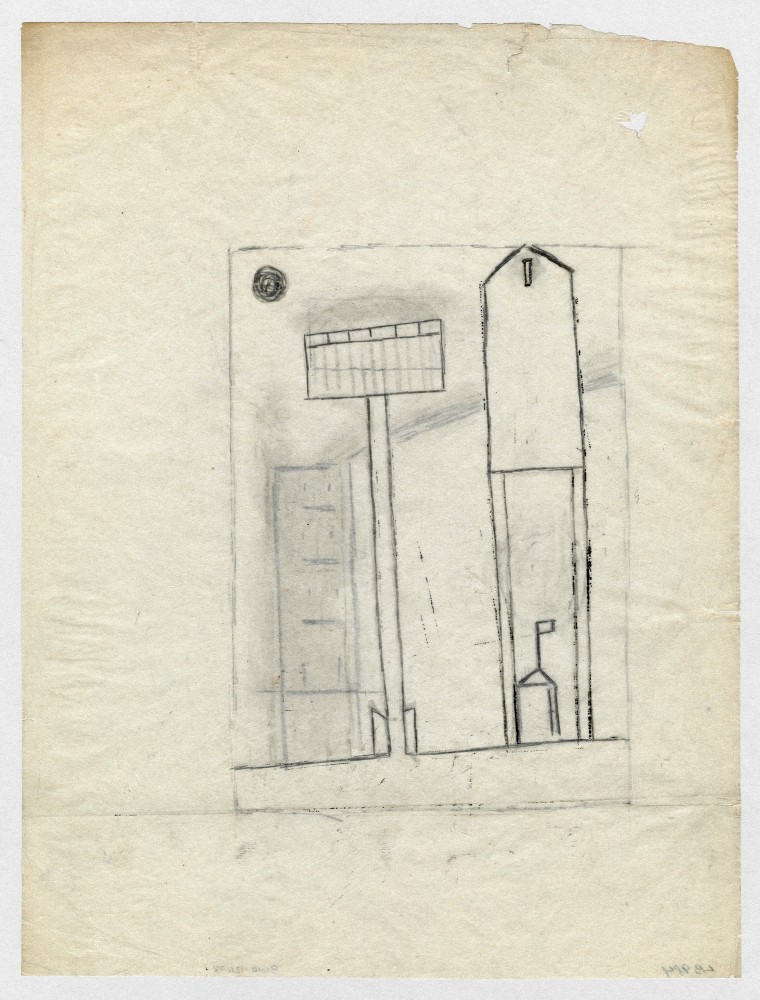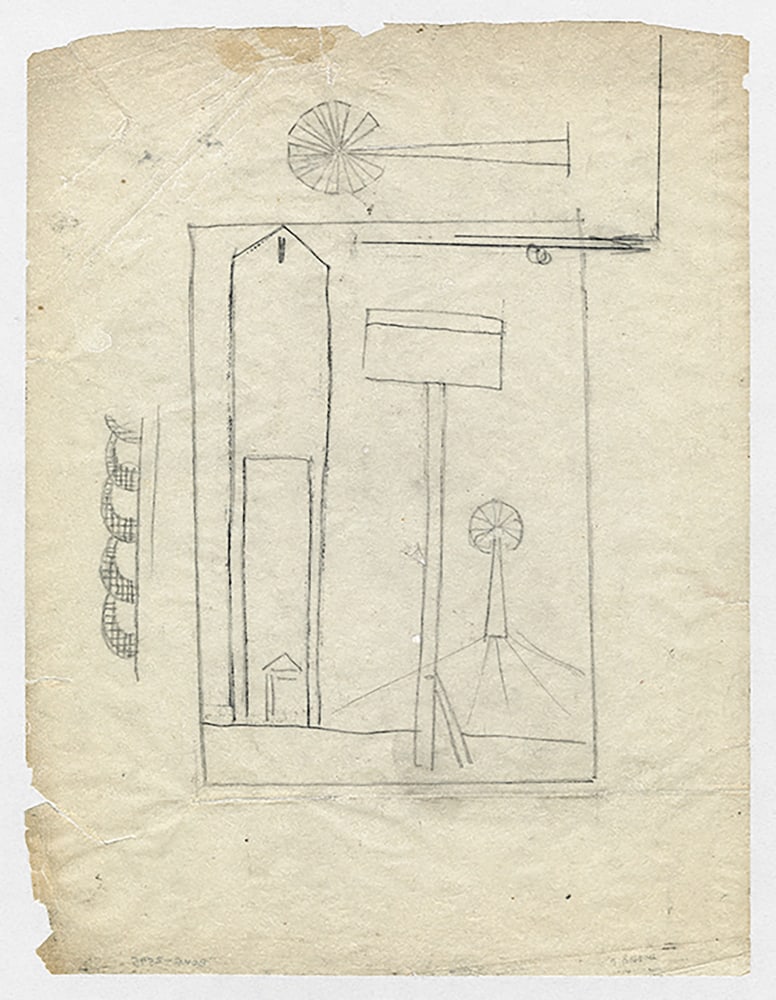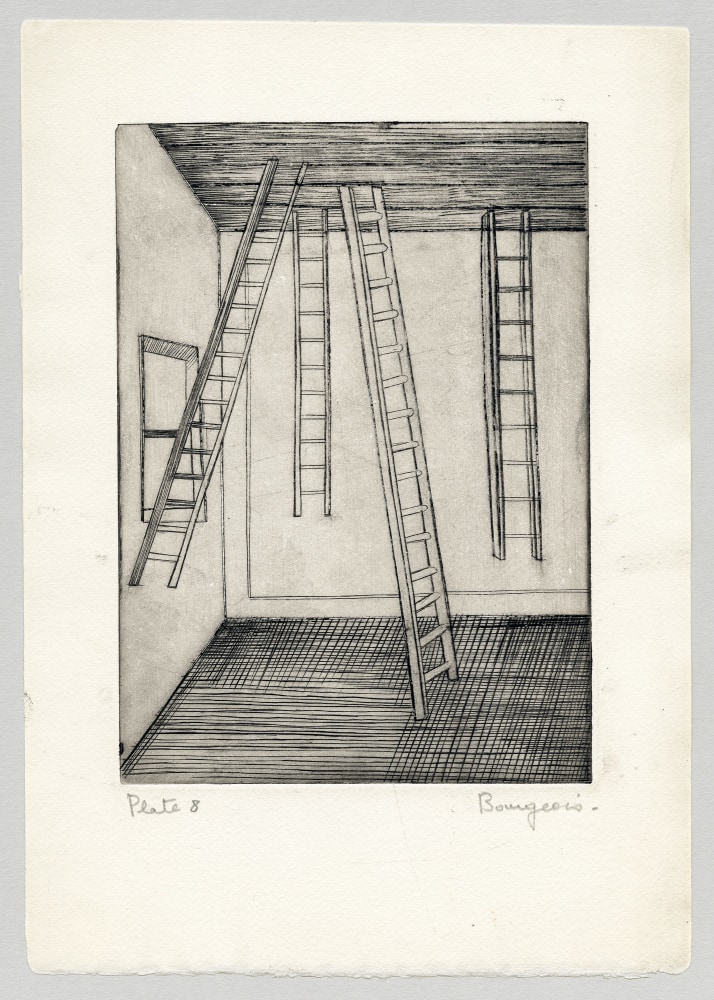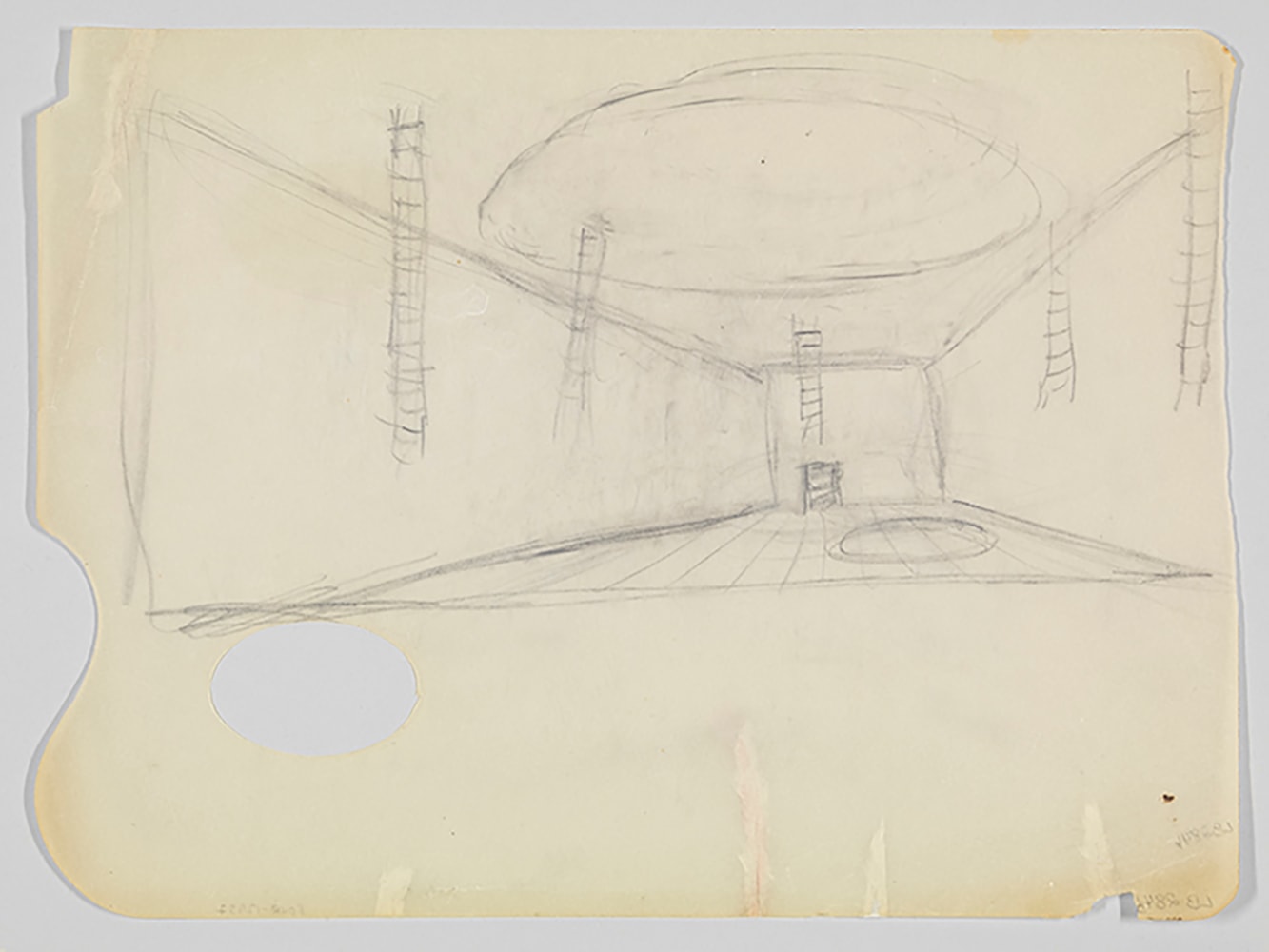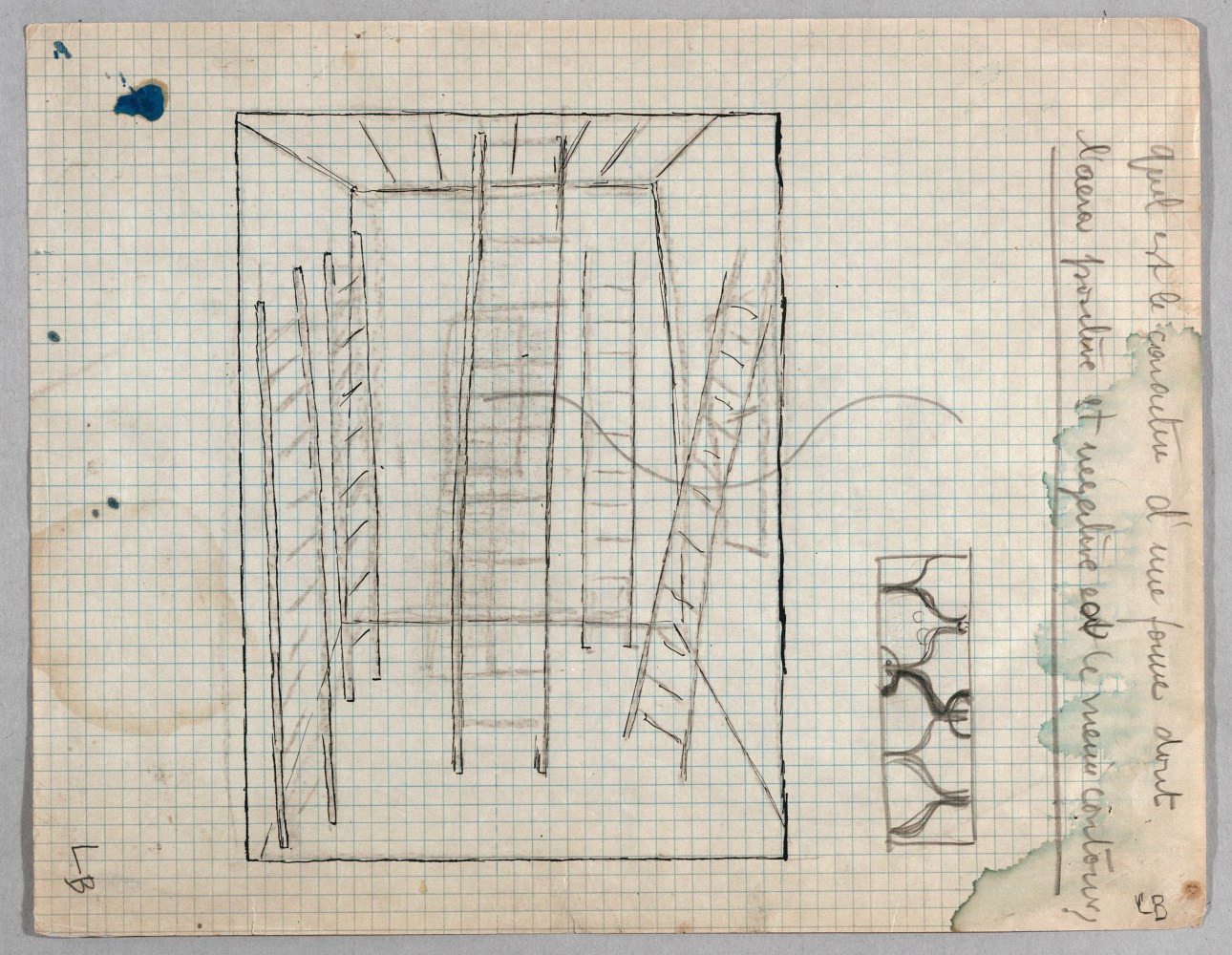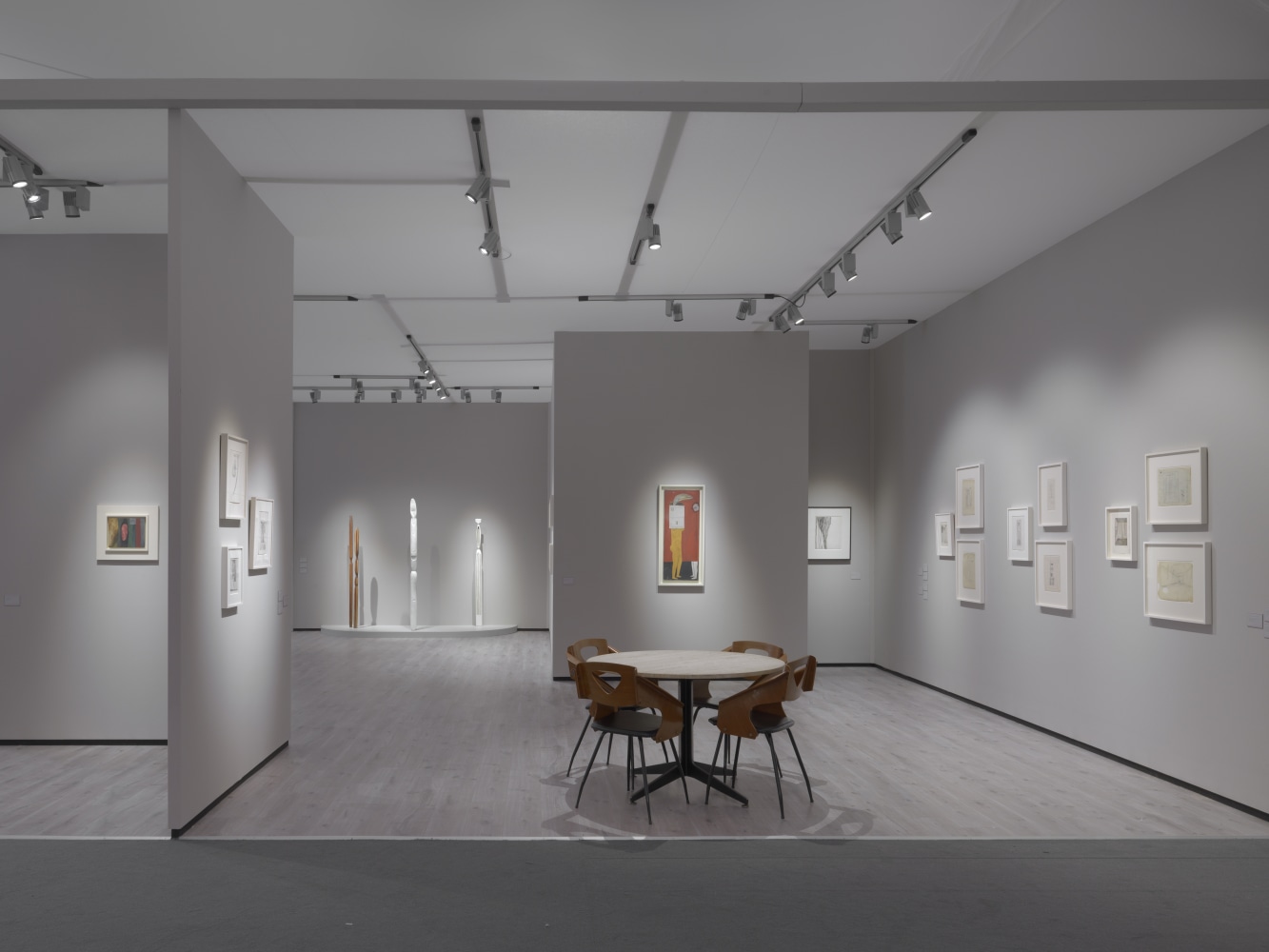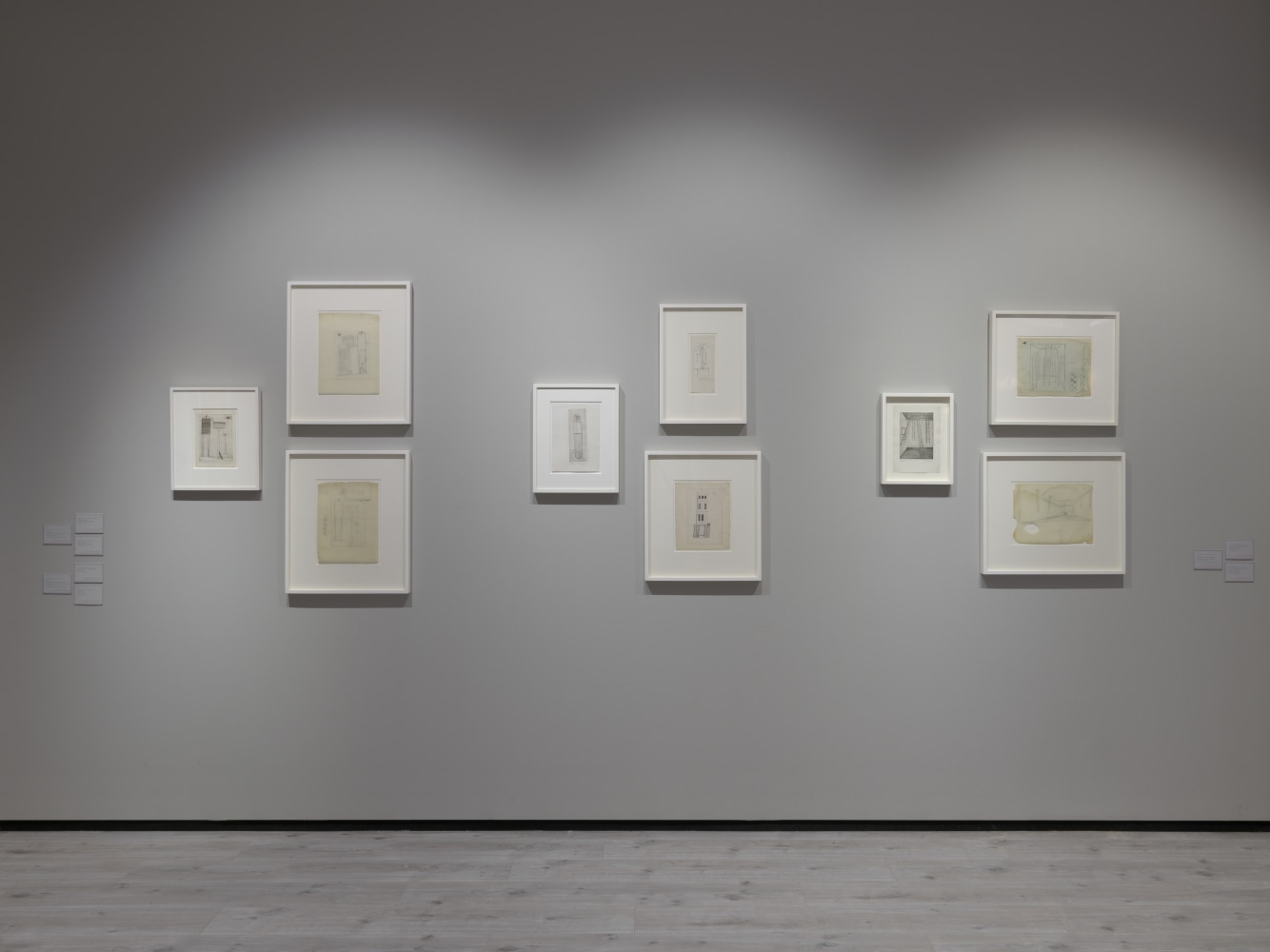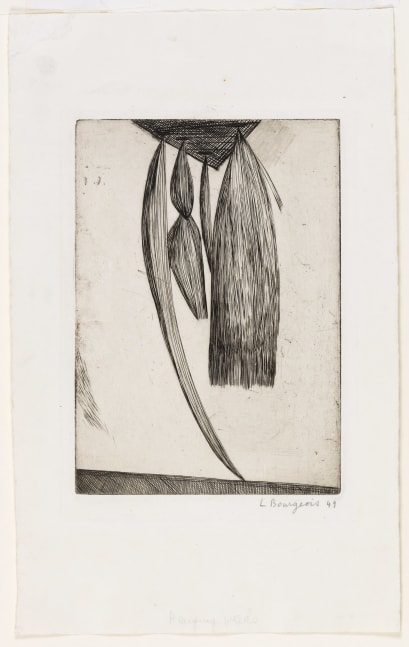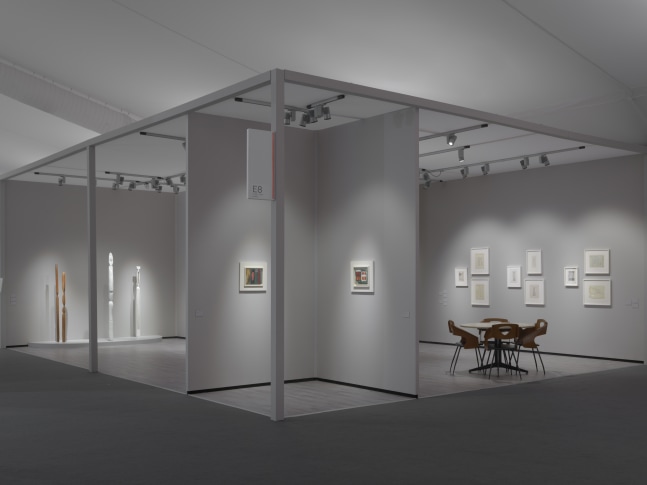Early Works by Louise Bourgeois: Sculptures, Paintings, and Works on Paper
Frieze Masters London
By David Crane
Early Works by Louise Bourgeois
I dreamt about you, we were running one after the other in a street full of skyscrapers. [1]
Louise Bourgeois dreamed of skyscrapers before she ever set foot in New York City. She wrote the above to her new husband, American art historian Robert Goldwater, shortly after their marriage in 1938. After only a month-long courtship, the two were married in Paris and Goldwater quickly returned to New York to prepare for his new wife’s arrival. Bourgeois, then as ever deeply attuned to the pull of the unconscious, already felt the presence of the city that would serve as her home for the rest of her life.
New York and its architecture—its densely packed blocks, gridded streets, lines of rowhouses and tenements, and, above all, the soaring high-rises and towers that loomed overhead—would indelibly shape Bourgeois and her work. Her immersion in, and absorption of, New York’s built environment occurred at the very moment she was crystallizing her artistic vision, and its impact can be clearly traced in the three bodies of works that inaugurated her singular, seven-decade-long career: the influential and iconic Femme Maison paintings (1946–47); her enigmatic and intimate illustrated book He Disappeared into Complete Silence (1947); and her pioneering first series of sculptures, the Personages (1946–54).
…you pile up the associations the way you pile up bricks…. Memory itself is a form of architecture. [2]
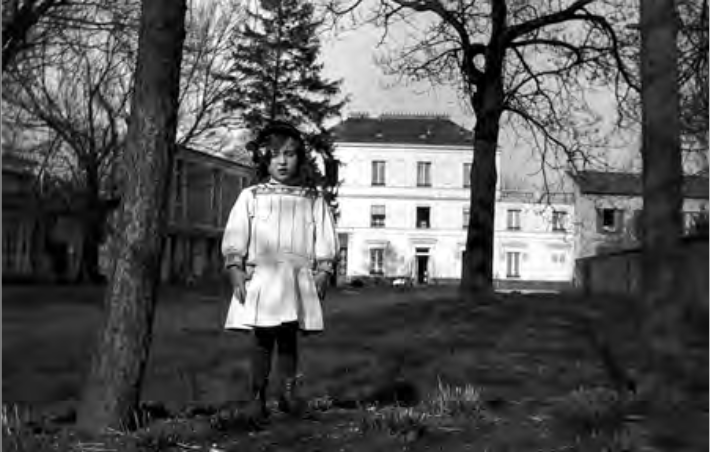
Louise Bourgeois in the garden of her home in Choisy-le-Roi in 1916.
Photo: © The Easton Foundation
From an early age, architecture shaped Bourgeois’s psychic life. As a young girl, she lived in large houses, first in Choisy-le-Roi, south of Paris near the Seine, and then in Antony, on the banks of the Bièvre River, where her parents successively operated their tapestry restoration workshops. These homes housed family as well as strangers—including not only the dozens of women working for the family business, but also her live-in English tutor, who would eventually become Bourgeois’s father’s mistress—situating the home in Bourgeois’s mind as an unstable site of constantly shifting and often opposing functions, at once domestic refuge, place of work, and sexual and psychological battleground. The particularities of the homes themselves—a destabilizing mixture of the familiar and the fantastic—impressed themselves on the young Bourgeois: both the pendulous, sagging skeins of wool from the workshop and the sloping, cavernous attic where her father’s collection of antique chairs hung from the rafters would emerge in various forms in her work throughout her career.
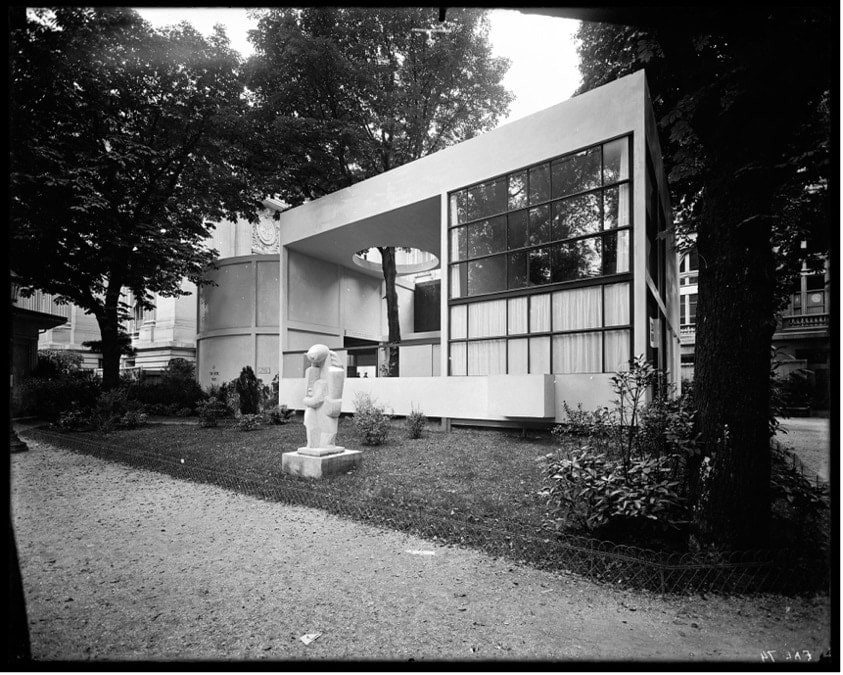
Le Corbusier, Pavillon L'Esprit Nouveau at the International Exhibition of Modern Decorative and Industrial Arts in Paris, 1925. © F.L.C. / ADAGP, Paris / Artists Rights Society (ARS), New York.
The practice, theory, and history of architecture would soon come to fascinate Bourgeois. Through her cousin, an architecture student, she discovered the geometric, visionary neoclassicism of Etienne-Louis Boulée and the architecture parlante of Claude-Nicholas Ledoux, which married form to purpose through the use of legible visual symbols. In 1925, Bourgeois visited the Exposition des Arts Décoratifs in Paris, an era-defining display that introduced Art Deco and other modernist styles to the wider public through exhibits and pavilions like Le Corbusier’s Pavilion de l’Esprit Nouveau, which the Swiss-French architect described as a “machine for living.” She would also come to understand the tapestries that surrounded her in her youth as a kind of “flexible architecture”: “In the beginning tapestries were indispensable, they were actually moving walls, or partitions in the great halls of castles and manor houses, or the walls of tents.” [3]
Suddenly I had this huge sky space to myself. [4]
Three years after their arrival in New York, Bourgeois and her family (now complete with three young sons) moved to 142 E. 18th Street, the oldest apartment building in the city, dubbed “Stuyvesant’s Folly” at the time of its completion for what was believed to be its misguided presumption that middle-class New Yorkers would embrace apartment living. The move proved to be a breakthrough for Bourgeois and her artistic practice, providing her not only with a spare room to serve as her studio, but an accessible rooftop where she was able to work in the open air, surrounded by the thrumming life of the city, its towers, tenements, and brownstones. Her work, which in the first half of the decade often featured figurative scenes of domestic life, soon grew more abstract, more surreal, and more architectonic, as architectural elements and fragments combined with, and soon replaced altogether, recognizably human forms.
During this period, Bourgeois moved, both socially and aesthetically, between the group of French Surrealists in exile from World War II and the nascent New York School without firmly belonging to either. As she had during the previous decade in Paris, Bourgeois constantly sought out opportunities to acquire additional skills and learn new techniques, enrolling soon after her arrival at the Art Students League, where she studied printmaking. During this period, she acquired a small printing press, which she installed in her family’s apartment, and adapted specialized techniques like etching and aquatint to her surroundings. Early prints like Youth (1941–44) reflect the domestic setting in which they were made: Bourgeois often etched her printing plates at the kitchen table and soaked them overnight in a safely diluted acid bath in the sink. [5]
In the fall of 1946, she began visiting Atelier 17, an avant-garde printmaking studio founded and run by Stanley William Hayter. Hayter had opened the studio in the late 1920s in Paris but, facing the growing threat of the war, relocated it to New York in 1940, where it attracted a lively community of students, emerging American artists, as well as a number of well-established artists in exile such as Joan Miró and Le Corbusier, whose “machine for living” Bourgeois had encountered two decades earlier. Le Corbusier and Bourgeois quickly became friends. [6] Both were deeply invested in the imbrication of the human and the architectural: Le Corbusier was at the time developing his Modulor system, a grand attempt to reorient the scale, form, and function of architecture to the human body, represented graphically by a semi-abstracted silhouette of a man with his arm raised. He would publish his theory in his 1948 book Le Modulor, apparently gifting a working drawing of the Modulor man to Bourgeois around this time. [7]
I consider this perfect … [Femme Maison] brings the personal together with the environment … it is a symbiosis of one with the universe … it is a kind of acceptance. [8]
While Le Corbusier was preparing for an architecture scaled to the proportions of the body, Bourgeois was exploring the potent psychological, emotional, and social echoes between humanity and the built environment, creating dreamlike amalgams that irrevocably fused the bodily and the architectonic. Chief among these is her iconic half-woman, half-house hybrid the Femme Maison, a complex figure that embodied the conflicting pressures Bourgeois found herself weathering as a young female artist balancing the competing demands of her career and her family. If the Femme Maison appears at times as a punning literalization of the archetypal “housewife,” obliterated and depersonalized by a dominating domesticity, the figure also provides a potentially liberatory vision of a “room of one’s own” that aligns with Bourgeois’s working methods at the time. As characterized by Lynne Cooke, the building that appears and morphs throughout the Femme Maison paintings “both shelters and imprisons: it is at once retreat, fortress, habitat, and [jail].” [9]
The symbolic act of engraving … it was an effective way of directly converting antagonism. [10]
At the center of this presentation is a rare copy of the illustrated book He Disappeared into Complete Silence (1947), one of only three of the ten known vintage copies still in private hands. Described by the artist as “a drama of the self,” the book was by far the most ambitious project Bourgeois had undertaken to that point and would serve as a decisive moment in her practice. [11] A suite of nine prints with accompanying texts written by the artist, the work presents “tiny tragedies of human frustration” in the words of Marius Bewley, the poet and scholar who wrote the introduction. Despite the physical effort required to create what Bourgeois described as the “very deliberate, very muscular … push line” of engraving, she adopted the technique, which she found both fascinating and frustrating, for the book. [12] Atelier 17, where Bourgeois worked on the plates and printed the images herself, was particularly influential for its experimental approach toward traditional intaglio techniques like engraving. For Bourgeois, “It was a revelation that you could get three-dimensional effects in drawing. It was a discovery … it was terribly exciting.” [13]
The compositions are stark and spare, beginning particularly with plate 1, in which a single, isolated vertical form appears: three architectonic elements stacked like a series of Brancusi pedestals, seeming to stare out at the viewer through a crosshairs-like symbol on its uppermost section. The sense of isolation—only a single horizon line denotes the setting—is ironically heightened by the facing parable, which declares the image an attempt to “show how beautiful” “a girl” was in “her good clothes and a new hat,” despite being stood up by her date. This initial spread thus succinctly posits the critical tensions—the disjuncture of image and text, the inadequacy of language, the subsumption of the human by the geometric and inanimate—that Bourgeois explores throughout the book.
My skyscrapers reflect a human condition. [14]
As the book progresses, Bourgeois assembles these enigmatic forms—at once architectonic and strangely human, imposing and precarious—like players on an empty stage: first one, then two, then three. The shifting arrangements gesture towards the potential of communion between them while at the same time underlining its impossibility: for Bourgeois, plate 2 is “peaceful, even though there is really no contact between the two,” while in plate 3, “Even the lighthouse [the central structure] moves closer, inviting jealousy. There are differences in the relationship.” [15] Transformations, reversals, and overdeterminations are common throughout the book: an abandoned easel becomes a guillotine; the lighthouse, previously an beacon of “guidance” in plate 3, appears to levitate in plate 6, signaling “the beginning of disintegration;” and in the final plate, plate 9, the three structures, despite being “overrun and broken by the flood,” “are still standing … there is still life here … there can be regeneration.” [16]
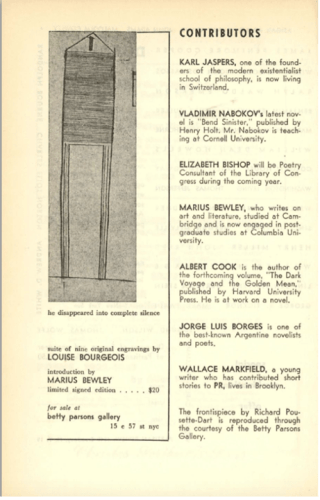
Partisan Review vol. XVI, no. 9 (September 1949), with advertisement for Louise Bourgeois, He Disappeared into Complete Silence, 1947
Because Bourgeois’s symbols so often embody contradictory impulses, they are in a constant state of metamorphosis in her work, which is reflected in her idiosyncratic approach to printmaking. Rather than employ the process of printmaking to publish uniform editioned works, Bourgeois saw the printing plate as a kind of palimpsest on which successive changes could be traced and recorded: “The whole history of the creative process is there. In painting or in sculpture, it would be gone.”[17] He Disappeared followed a more traditional form, with a predetermined edition, and as such was positioned as an ambitious endeavor to make a name for herself: Bourgeois took out advertisements for the project in three issues of Partisan Review and reached out to prominent dealers and critics. However, there was not as much interest as she had hoped and, though originally planned as an edition of 54, Bourgeois never completed the labor-intensive editioning process. There are thus only ten books known to be from this period, each with slight differences, which have been designated as “vintage” examples. As of 2018, there are also nine “assembled” examples, put together by Bourgeois over the years using materials from the 1940s still in her possession. In 2005, Bourgeois published a second edition, finally completing the project that had frustrated her for so long. Having lost the original plates, she worked extensively with printers to recreate them, and ultimately published the book with added touches of watercolor as well an additional composition.
My complaint about language is that it is perfect, indispensable, but not enough. It doesn’t say everything. [18]
The role of translator was one Bourgeois had often played, sometimes willingly, often begrudgingly, and at times even unconsciously. Encouraged by her father, who wanted her to take over the family tapestry business, Bourgeois studied English from a young age. In her twenties she worked as an English-speaking docent giving tours in the Louvre and as a translator for Fernand Léger when she studied in his atelier. In the 1940s, homesick in a new country, Bourgeois was eager for companionship and collegiality with her fellow countrymen, but, though she moved in the same social circles as Breton, Duchamp, and others, she found herself dismissed as “just a girl.” [19] Despite this, she was often depended upon by these same artists to facilitate communication with their American counterparts; trapped and constricted by the language of others, she found herself reduced to a mere intermediary rather than a true interlocutor.
The short and surreal parables she wrote for He Disappeared draw on these frustrations, detailing, in a darkly comic deadpan, a litany of miscommunications and failures that lead ultimately, and inexorably, to isolation and alienation. This is perhaps most clearly exemplified by the third text, which runs in full: “Once a man was telling a story, it was a very good story too, and it made him very happy, but he told it so fast that nobody understood it.” This theme is heightened by the fact that the texts do not narrate the engravings, nor do the images illustrate the stories. Bourgeois wrote them separately from her work on the prints—"When inspiration would come I would write one. I didn’t do them all at once”—and texts were often paired with various images throughout the evolution of the project. [20] For Bourgeois, writing was “not completely satisfactory,” but she believed that “you can stand anything if you write it down.” [21] Language was thus both liberatory and constraining, fraught with fluctuating social and psychological dynamics, a therapeutic and communicative tool that was nonetheless marred by traps, slips, and other inherent insufficiencies.

Left: Deux Figures Qui Portent Un Object, 1950 Wood, 66 1/2 x 15 x 12 inches.
Center: Depression Woman, 1949-1950. Painted wood, 76 x 12 x 12 inches.
Right: Pillar, 1949-1950. Painted wood, 64 1/2 x 12 x 12 inches.
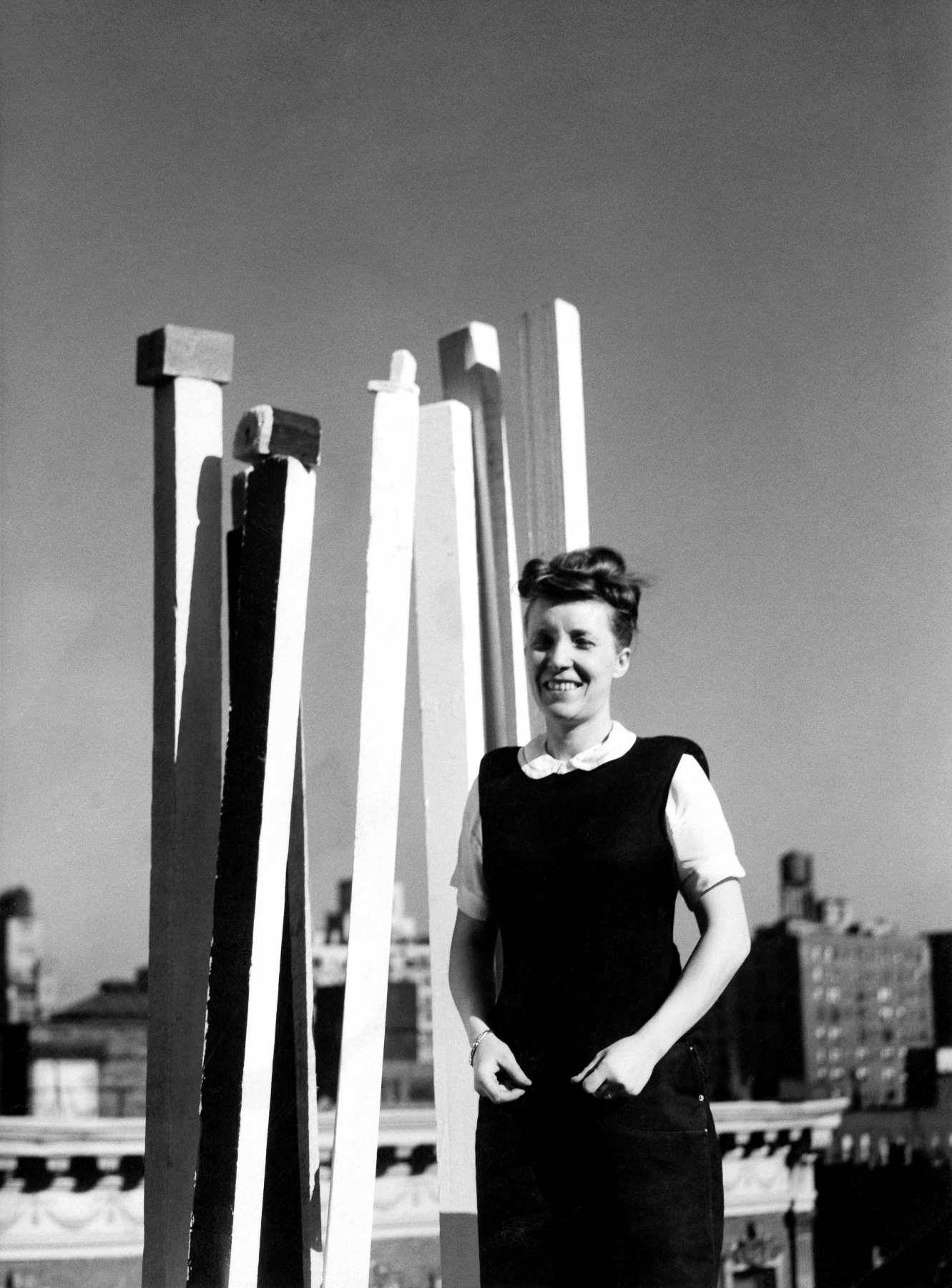
Louise Bourgeois with her sculpture on the roof of her NYC apartment building, circa 1944.
Photo: © The Easton Foundation/Licensed by VAGA at ARS, NY.
[The Personages] were life-size in a real space and made to be seen in groups. [22]
Fascinated by her revelatory experience of the material process of engraving, Bourgeois embraced the “real cutting” of sculpture, debuting her series of Personages in solo exhibitions at the Peridot Gallery in 1949, 1950, and 1953. By roughly carving, gouging, honing, and painting planks of balsa wood, often on the roof of Stuyvesant’s Folly, Bourgeois created looming, leaning totem-like presences that resemble the architectonic forms that populated the plates of He Disappeared, or, at their most simplified, the stilt-like appendages on which many of the printed forms stand. These stilts are at once a method of protection, raised above the dangers of flood or invasion, as well as a symbol of precarity: “Suspicion grows when you do not trust the ground anymore.” [23] These stilts are another point of confluence and exchange with her friend Le Corbusier, who enshrined his own pilotis as one of the Five Points of Modern Architecture and was developing a design for the United Nations headquarters that incorporated them during his time in New York. In the Personages, Bourgeois frees these instruments of support to stand on their own, as in her sculpture Pillar (1949–50), transmogrifying the architectural back into the human. Indeed, as described by the artist, the planks of wood out of which she crafted the Personages were used for the construction of the rooftop water towers she was surrounded by as she worked on the sculptures in her “sky space.” [24]
This transformation was not only material: as alluded to in their collective title, Bourgeois stated that these raw, abstract monoliths “were conceived of and functioned as figures,” a way of “rebuilding” around her the friends and family she had left behind in France. [25] Their translation into real space subverted the sense of the loneliness that pervaded the images and texts of He Disappeared. In the artist’s groundbreaking shows at Peridot, early examples of environmental installation, she dispersed the sculptures throughout the gallery without stands or pedestals, creating a social space that included not only the works themselves but the viewers as well.
Throughout the 1940s, forms and fragments—bodily and architectural—reappear, transform, and transpose across Bourgeois’s prints, paintings, drawings, and sculptures. Foremost among these is a simplified house-form: a triangle atop a square or rectangle. As it moves between painting, print, and sculpture, the house constantly shifts in appearance and function: adjoined to, and merged with, the female body in Femme Maison; a transparent silhouette in plate 4 of He Disappeared, with a lonely fire burning inside; opaque and adorned with abstract symbols in plate 6, “where there is an attempt to restrain the hostility by hiding in the house”; as well as in Pillar, in which it rests perilously upside-down at the crown of the work. [26] For Bourgeois—who was always repeating, revising, reconfiguring—the home is never static but constantly in flux, forever mutating: a head, a body, a pillar, a plank, a tower, a cage, a refuge.
Additional captions in order of appearance:
Untitled (Plate 8 from He Disappeared into Complete Silence), 1947 (detail). Pencil and ink on paper, 8 1/2 x 11 inches. © The Easton Foundation / VAGA at Artists Rights Society (ARS), NY.
Craig F. Starr Gallery, Frieze Masters, London, 2021. Art © The Easton Foundation / VAGA at Artists Rights Society (ARS), NY.
Jeunesse (Youth), 1944. Soft ground etching, drypoint, and aquatint on paper, 5 x 7 1/2 inches, plate; 7 7/8 x 11 1/4 inches, sheet. © The Easton Foundation / VAGA at Artists Rights Society (ARS), NY.
Craig F. Starr Gallery, Frieze Masters, London, 2021. Art © The Easton Foundation / VAGA at Artists Rights Society (ARS), NY.
Notes:
[1] Bourgeois, letter to Robert Goldwater, September 24, 1938; LB-1715 quoted in Deborah Wye, Louise Bourgeois: An Unfolding Portrait: Prints, Books, and the Creative Process, (New York: The Museum of Modern Art, 2017), 37.
[2] Bourgeois, quoted in Joseph Helfenstein, “Louise Bourgeois: Architecture as a Study in Memory,” in Louise Bourgeois: Memory and Architecture, eds. Jerry Gorovoy and Danielle Tilkin (Madrid: Museo Nacional de Arte Reina Sofia, 1999), 26.
[3] Louise Bourgeois, “The Fabric of Construction,” in Craft Horizons, vol. 29, no. 2 (March–April 1969), p. 33.
[4] Bourgeois, quoted in Michael Brenson, “A Sculptor Comes into Her Own,” The New York Times, October 31, 1982, Arts & Leisure Section: 1, in Robert Storr, Intimate Geometries: The Art and Life of Louise Bourgeois (New York: Monacelli Press, 2016), 126.
[5] Mignon Nixon, Fantastic Reality: Louise Bourgeois and a Story of Modern Art (Cambridge, MA: MIT Press, 2006), 56.
[6] Bourgeois’s decades-later installation Passage Dangereux (1997) includes a small glass figurine of a horse, a gift she received from Le Corbusier in the mid-1940s. See Storr, Intimate Geometries, 525.
[7] Paulo Herkenhoff, “Le Corbusier,” in Frances Morris, et al., Louise Bourgeois (London: Tate Publishing, 2007), 89.
[8] Bourgeois quoted in Deborah Wye and Carol Smith, The Prints of Louise Bourgeois (New York: The Museum of Modern Art, 1994), 148.
[9] Cooke, “Farewell to the Doll House,” in Louise Bourgeois: Memory and Architecture, 63.
[10] Bourgeois quoted in Deborah Wye and Carol Smith, The Prints of Louise Bourgeois, 23.
[11] Ibid, 72.
[12] Ibid, 23.
[13] Ibid.
[14] Bourgeois, quoted in “Architecture,” in Louise Bourgeois: The Complete Prints & Books, ed. Deborah Wye. New York: The Museum of Modern Art, 2018. https://www.moma.org/s/lb/curated_lb/themes/architecture.html
[15] Bourgeois quoted in Deborah Wye and Carol Smith, The Prints of Louise Bourgeois, 78 and 80.
[16] Ibid, 80, 86, and 92.
[17] Ibid, 23.
[18] Ibid, 14.
[19] Bourgeois quoted in Nixon, Fantastic Reality: Louise Bourgeois and a Story of Modern Art, 19. See also page 16: “It was the Left Bank again and although I was now close to them, I objected to them violently. They were so lordly and pontifical.”
[20] Bourgeois quoted in Deborah Wye and Carol Smith, The Prints of Louise Bourgeois, 72.
[21] Ibid.
[22] Louise Bourgeois, “Brief Account of a Career” (c. 1965), in Destruction of the Father/Reconstruction of the Father: Writings and Interviews 1923-1997, ed. Marie-Laure Bernadac and Hans-Ulrich Obrist (London: Violette Editions, 1998), 77.
[23] Bourgeois quoted in Deborah Wye and Carol Smith, The Prints of Louise Bourgeois, 86.
[24] Alain Kirili, “The Passion for Sculpture: A Conversation with Louise Bourgeois,” Arts Magazine, March 1989, 72.
[25] Bourgeois, “Brief Account of a Career” (c. 1965), in Destruction of the Father/Reconstruction of the Father, 77.
[26] Bourgeois quoted in Deborah Wye and Carol Smith, The Prints of Louise Bourgeois, 89.
